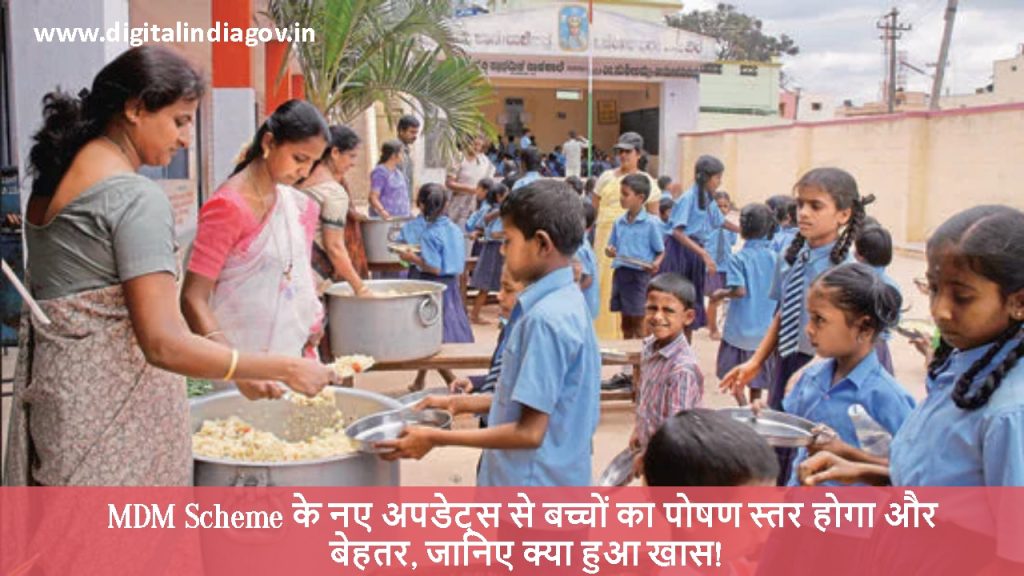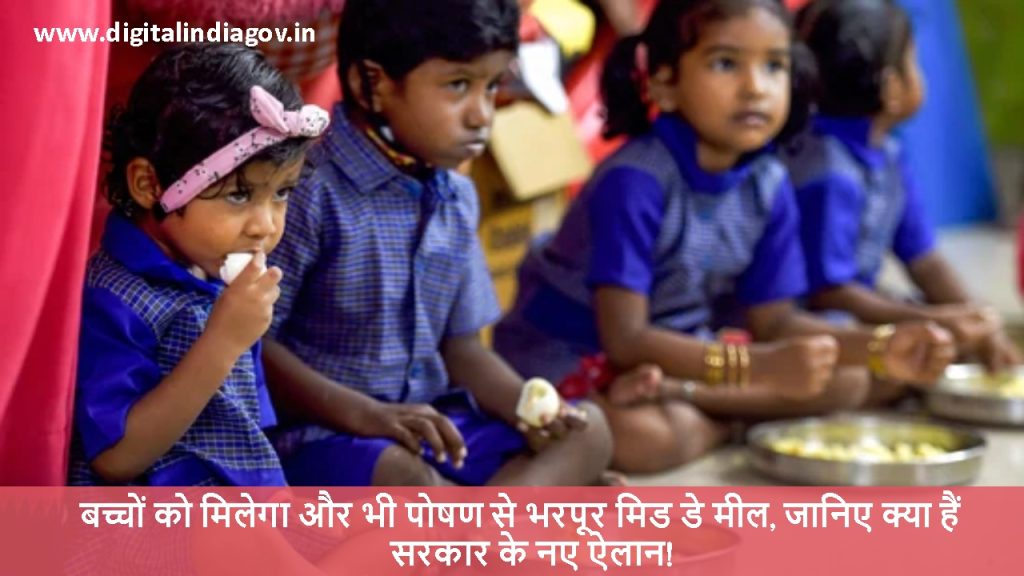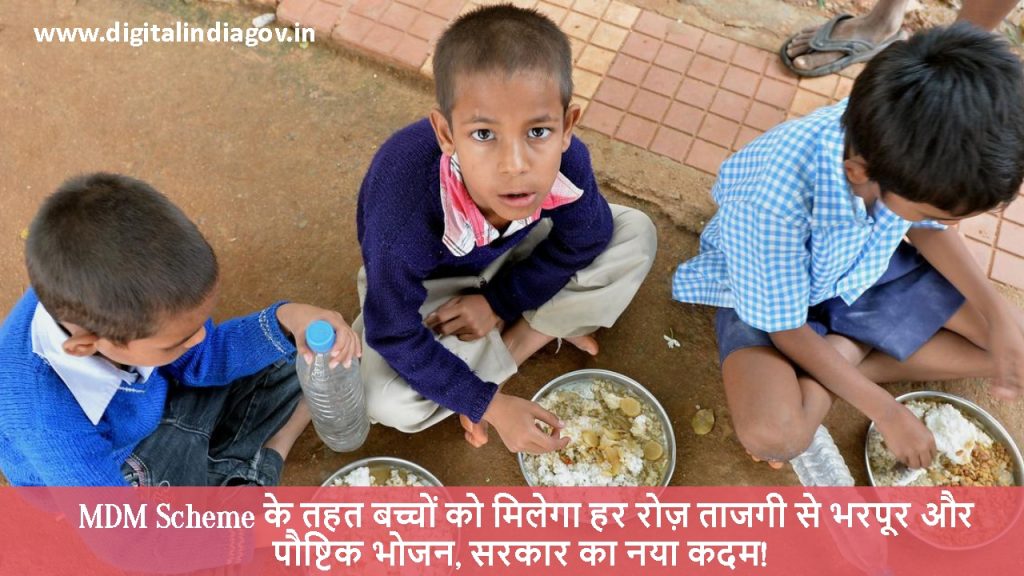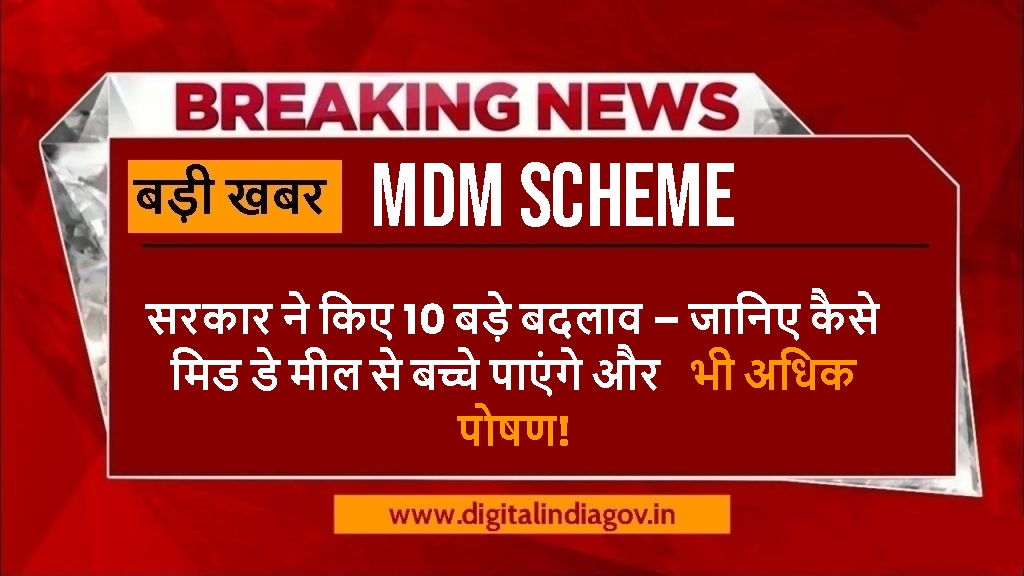MDM Scheme, भारत सरकार द्वारा शुरू की गई सबसे व्यापक और प्रभावी सामाजिक पहलों में से एक मिड-डे मील योजना (एमडीएम योजना) है। स्कूली बच्चों की पोषण स्थिति और शैक्षणिक प्रदर्शन को बढ़ाने के लिए बनाई गई एमडीएम योजना उन्नति, समानता और आशा का प्रतिनिधित्व करती है। इस विस्तृत लेख में मिड-डे मील योजना के हर पहलू को शामिल किया जाएगा, जिसमें इसके लक्ष्य, पृष्ठभूमि, कार्यान्वयन, लाभ, कठिनाइयाँ, प्रभाव और पीएम पोषण के तहत सबसे हालिया अपडेट शामिल हैं।
Contents
Introduction to the MDM Scheme (एमडीएम योजना का परिचय)
Children in Classes I through VIII in government and government-aided schools throughout India are given free, wholesome prepared meals under the Mid-Day Meal Scheme (MDM), a centrally sponsored program. The program acts as a financial incentive for education and nutrition, particularly for kids from lower-income families. In rural India, it is also crucial for improving social justice, generating jobs, and empowering women.
Evolution and History of the MDM Scheme (एमडीएम योजना का विकास और इतिहास)
Pre-Independence Initiatives
- The concept of school meals in India can be traced back to 1925, when the Madras Municipal Corporation started a mid-day meal program for underprivileged children.
- In the 1960s to 1980s, several states like Tamil Nadu, Kerala, and Gujarat implemented state-level meal programs successfully.
National-Level Launch
- The MDM Scheme was officially launched as the National Programme of Nutritional Support to Primary Education (NP-NSPE) on 15th August 1995.
- Initially, it involved the distribution of dry rations (food grains).
Introduction of Cooked Meals
- In 2001, the Supreme Court of India mandated all states to provide cooked meals instead of just dry grains.
- This was a turning point and marked the scheme’s transformation into a holistic health and education initiative.

Also Read: Yout Mobility Scheme, yojanaforall.com, Typingspeedtestonline, Onlinereferjobs
Main Objectives of the MDM Scheme (एमडीएम योजना के मुख्य उद्देश्य)
इस योजना को कई परस्पर जुड़े उद्देश्यों के साथ डिज़ाइन किया गया है:
बाल पोषण में सुधार
इसका मुख्य उद्देश्य 6-14 वर्ष की आयु के बच्चों में कुपोषण से लड़ना है, ताकि उन्हें हर स्कूल के दिन पौष्टिक रूप से संतुलित पका हुआ भोजन उपलब्ध कराया जा सके।
नामांकन और उपस्थिति को बढ़ावा देना
मुफ़्त भोजन की पेशकश करके, यह योजना माता-पिता को अपने बच्चों को स्कूल भेजने के लिए प्रोत्साहित करती है, खासकर गरीब और ग्रामीण समुदायों में।
प्रतिधारण दर में वृद्धि
भूख स्कूल छोड़ने का सबसे बड़ा कारण है। मुफ़्त, गर्म भोजन बच्चों को लंबे समय तक स्कूल में रखता है।
सामाजिक समानता और समावेश को बढ़ावा देना
सभी जातियों और समुदायों के बच्चे एक साथ भोजन करते हैं, जिससे भारत जैसे विविधतापूर्ण देश में सामाजिक सद्भाव और एकता को बढ़ावा मिलता है।
कामकाजी महिलाओं का समर्थन करें
एमडीएम के तहत कार्यरत कई रसोइया और सहायक ग्रामीण महिलाएँ हैं, जिससे महिला सशक्तिकरण और आर्थिक स्वतंत्रता को बढ़ावा मिलता है।
Target Beneficiaries of the Scheme (योजना के लक्षित लाभार्थी)
The scheme targets the most vulnerable and underserved children in Indian society. The beneficiaries include:
- Children studying in Classes I to VIII
- Enrolled in:
- Government schools
- Government-aided schools
- Special Training Centers
- Madarsas and Maqtabs supported under the Sarva Shiksha Abhiyan (SSA)
- Orphaned and street children in recognized institutions may also be included in some states
Also Read: RUSA Scheme, Mobilenumbertrackeronline, ssorajasthanidlogin.com, shaladarpanportalgov.com
Nutritional Standards and Food Menu (पोषण मानक और भोजन मेनू)
Nutritional Requirements (Per Child Per Day)
| Category | Energy (Calories) | Protein (Grams) |
| Primary (Classes I-V) | 450 kcal | 12g |
| Upper Primary (Classes VI-VIII) | 700 kcal | 20g |
Example Menu (Varies by State)
- Cereals: Rice, Chapati
- Pulses: Dal, Chana, Rajma
- Vegetables: Seasonal greens, potatoes, carrots, etc.
- Fats: Oil or ghee used in cooking
- Milk & Eggs: Included in states like Andhra Pradesh, Odisha, Tamil Nadu
- Fruits: Occasionally provided
- Special Items: Sweets or festive meals during festivals or “Tithi Bhojan”

Implementation Structure of the MDM Scheme (एमडीएम योजना की कार्यान्वयन संरचना)
Central Government Role
- Supplies food grains free of cost via Food Corporation of India (FCI)
- Offers financial assistance for:
- Cooking cost
- Honorarium to cooks/helpers
- Construction of kitchens
- Purchase of utensils
State Government Role
- Appoints cooking staff and helpers
- Adds local ingredients to meals
- Manages on-ground supervision and monitoring
Cooking and Distribution
- Meals are mostly cooked in schools using in-house or community kitchens.
- In some urban areas, NGOs and centralized kitchens (like Akshaya Patra) deliver hot meals to multiple schools.
Budget Allocation and Cost Sharing (बजट आवंटन और लागत साझाकरण)
फंड शेयरिंग मॉडल
- अधिकांश राज्य केंद्र और राज्य सरकारों के बीच 60:40 के अनुपात का पालन करते हैं।
- उत्तर-पूर्वी और हिमालयी राज्यों के लिए, यह 90:10 है।
- विधानसभा रहित केंद्र शासित प्रदेशों को केंद्र से 100% धन प्राप्त होता है।
वार्षिक व्यय (2023-24)
- केंद्रीय बजट में ₹11,600 करोड़ से अधिक आवंटित।
- व्यक्तिगत राज्यों और दाता संगठनों द्वारा अतिरिक्त आवंटन।
Impact of the MDM Scheme on India (भारत पर एमडीएम योजना का प्रभाव)
The MDM Scheme has had multi-dimensional impacts:
Educational Impact
- Increase in school enrollment, especially girl and marginalized groups.
- Improvement in attendance and punctuality.
- Better academic performance and classroom behavior.
Nutritional and Health Benefits
- Improved levels of hemoglobin, BMI, and nutritional intake.
- Decrease in cases of malnourishment and anemia.
Social Integration
- Caste-based discrimination has been challenged as children eat together regardless of background.
- Women have been empowered through employment as cooks and helpers.
Key Challenges Faced by the MDM Scheme (प्रमुख चुनौतियाँ)
Quality Control Issues
- Cases of food poisoning or unhygienic meals have been reported in some schools.
- Lack of proper storage and sanitation facilities.
Leakages and Corruption
- Misreporting of attendance
- Diversion of grains or funds
- Inflated bills and mismanagement
Inadequate Nutrition
- Sometimes meals lack diversity or proper caloric value due to budget constraints.
Irregular Payments
- Cooks and helpers are often underpaid or face delayed payments.

Also Read: DISHA Scheme, Digitizeindiagovin.com, Nebsit Council
Conclusion (निष्कर्ष)
भूखे बच्चों को भोजन उपलब्ध कराने के अलावा, मिड-डे मील योजना का उद्देश्य गरीबी के चक्र को समाप्त करना, भारत के भविष्य की नींव को बेहतर बनाना और समुदायों को सशक्त बनाना है। हम यह सुनिश्चित करके गारंटी देते हैं कि समानता, स्वास्थ्य और शिक्षा के संघर्ष में कोई भी बच्चा पीछे न छूटे, कि उन्हें हर दिन गर्म, पौष्टिक भोजन मिले। जैसे-जैसे यह कार्यक्रम पीएम पोषण के तहत विकसित होगा, इसकी पहुंच और प्रभाव बढ़ता जाएगा, जिससे अधिक बुद्धिमान, स्वस्थ और न्यायपूर्ण भारत का द्वार खुलेगा।
Faq’s
Q. What is the Mid-Day Meal Scheme’s primary objective?
Ans: to feed schoolchildren wholesome meals to promote their development, health, and education.
Q. The MDM Scheme is financed by whom?
Ans: The Central and State Governments split money for this centrally sponsored program.
Q. What is PM POSHAN different from MDM?
Ans: The MDM Scheme, which was introduced in 2021 with new features and improvements, is now known as PM POSHAN.
Q. Does the program cover private schools?
Ans: No, only public and government-supported schools are included.
@PAY
